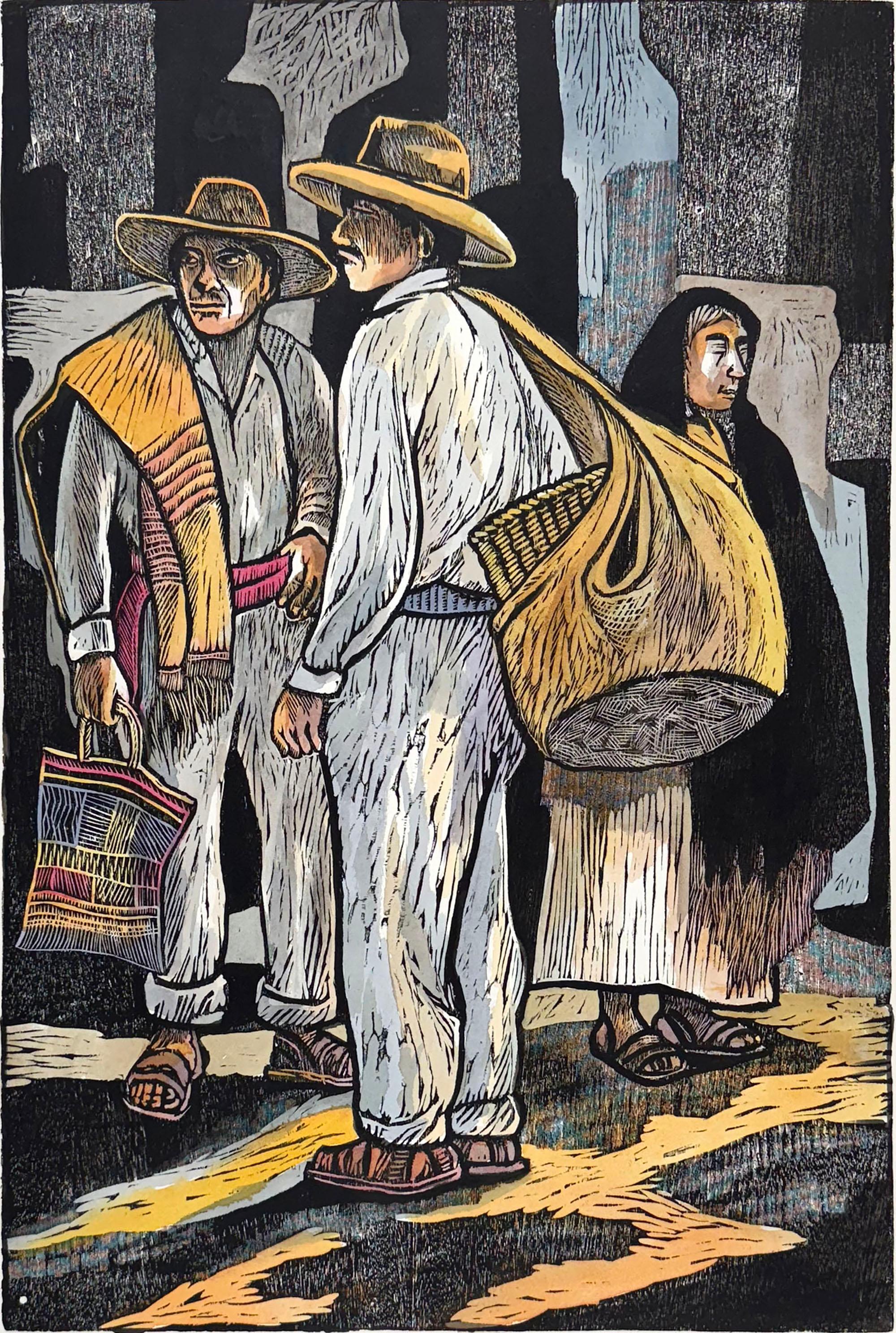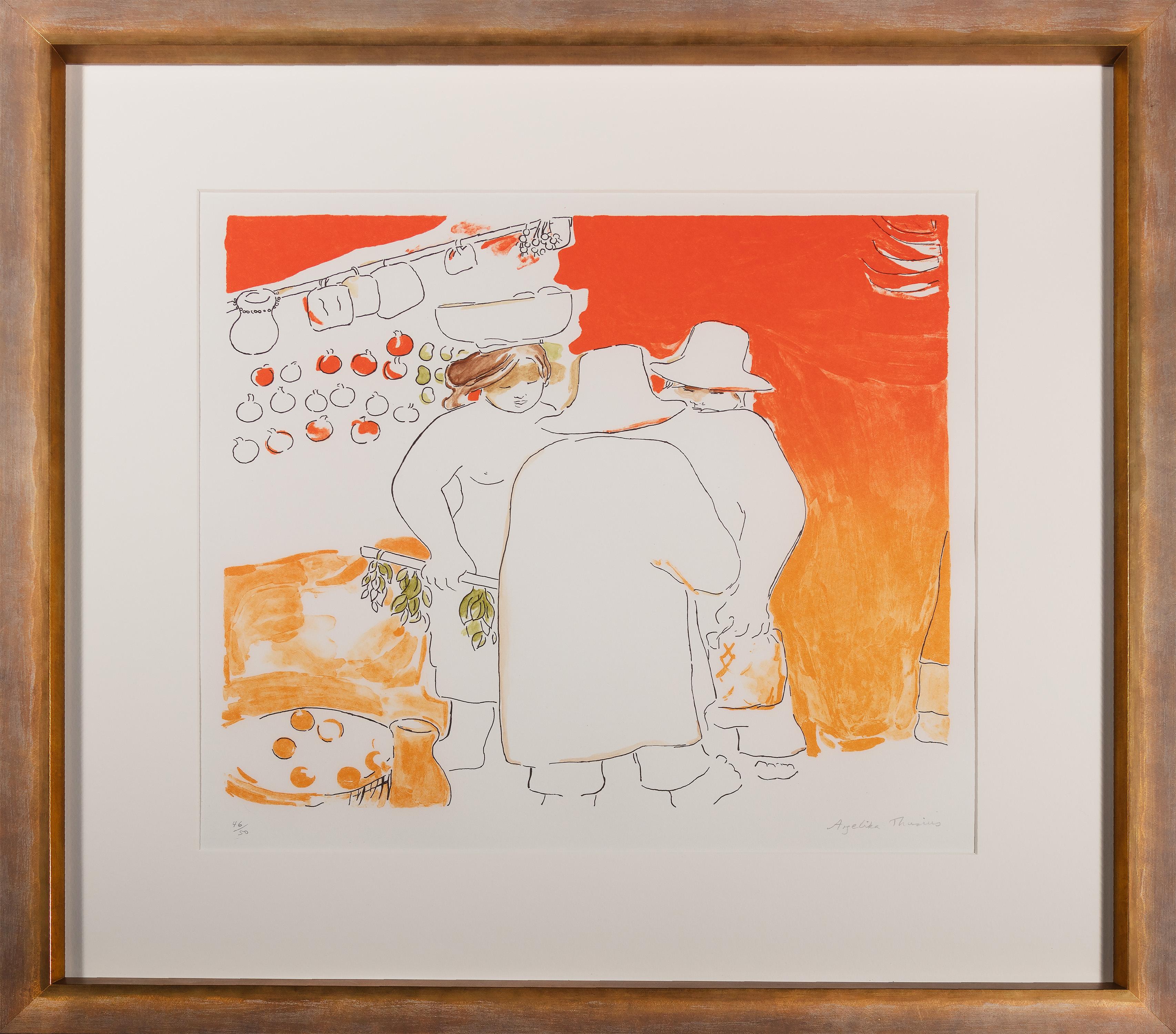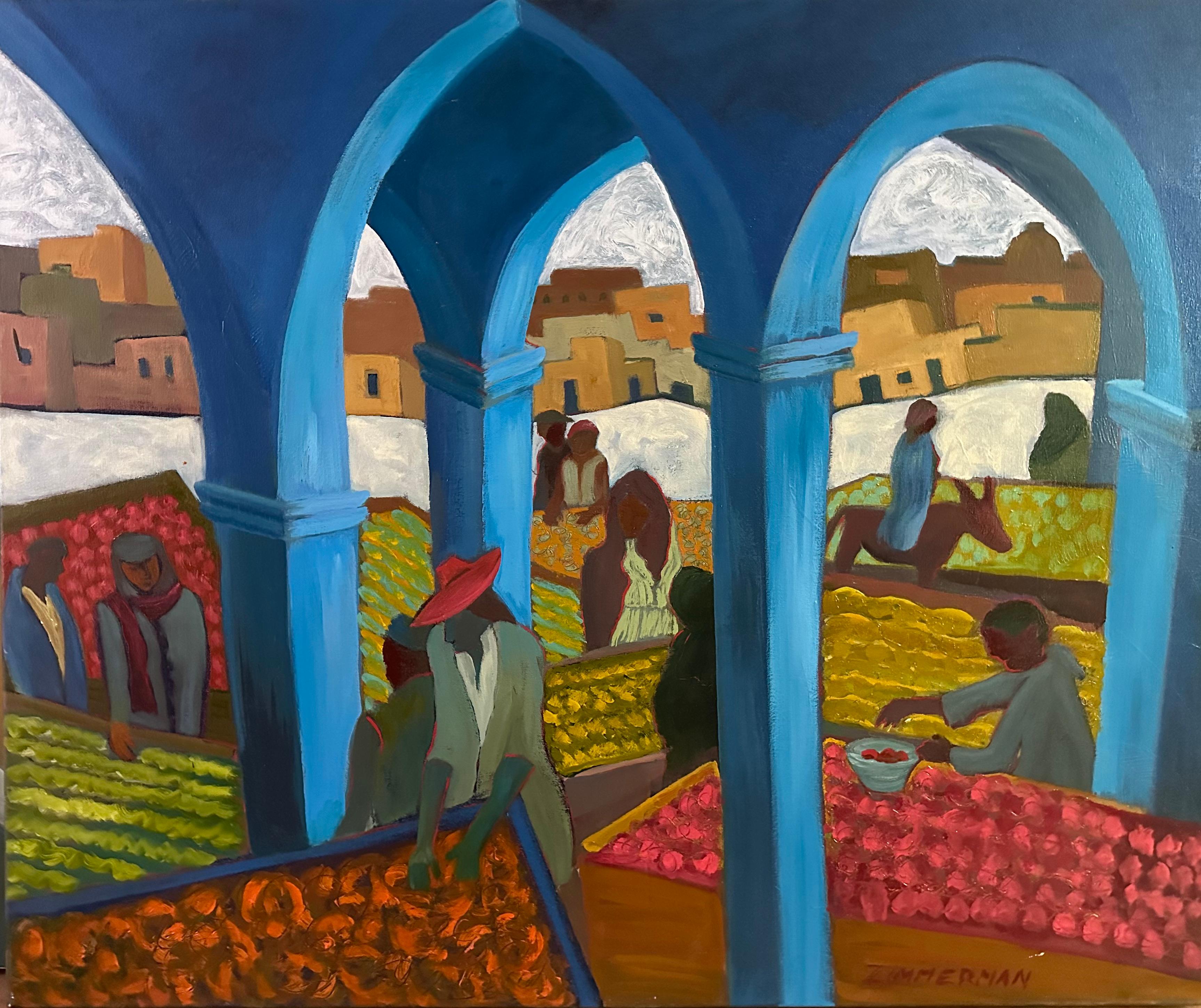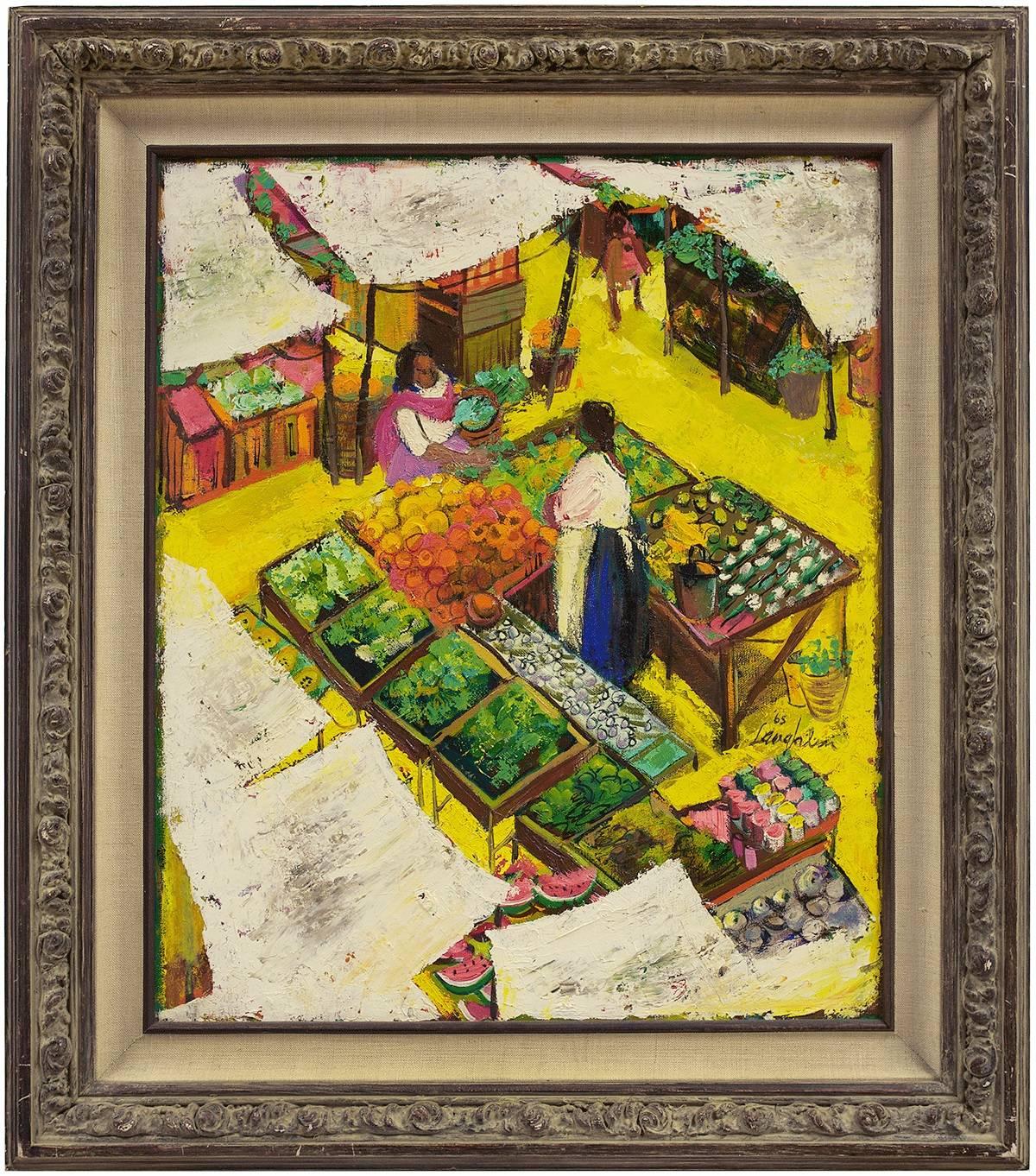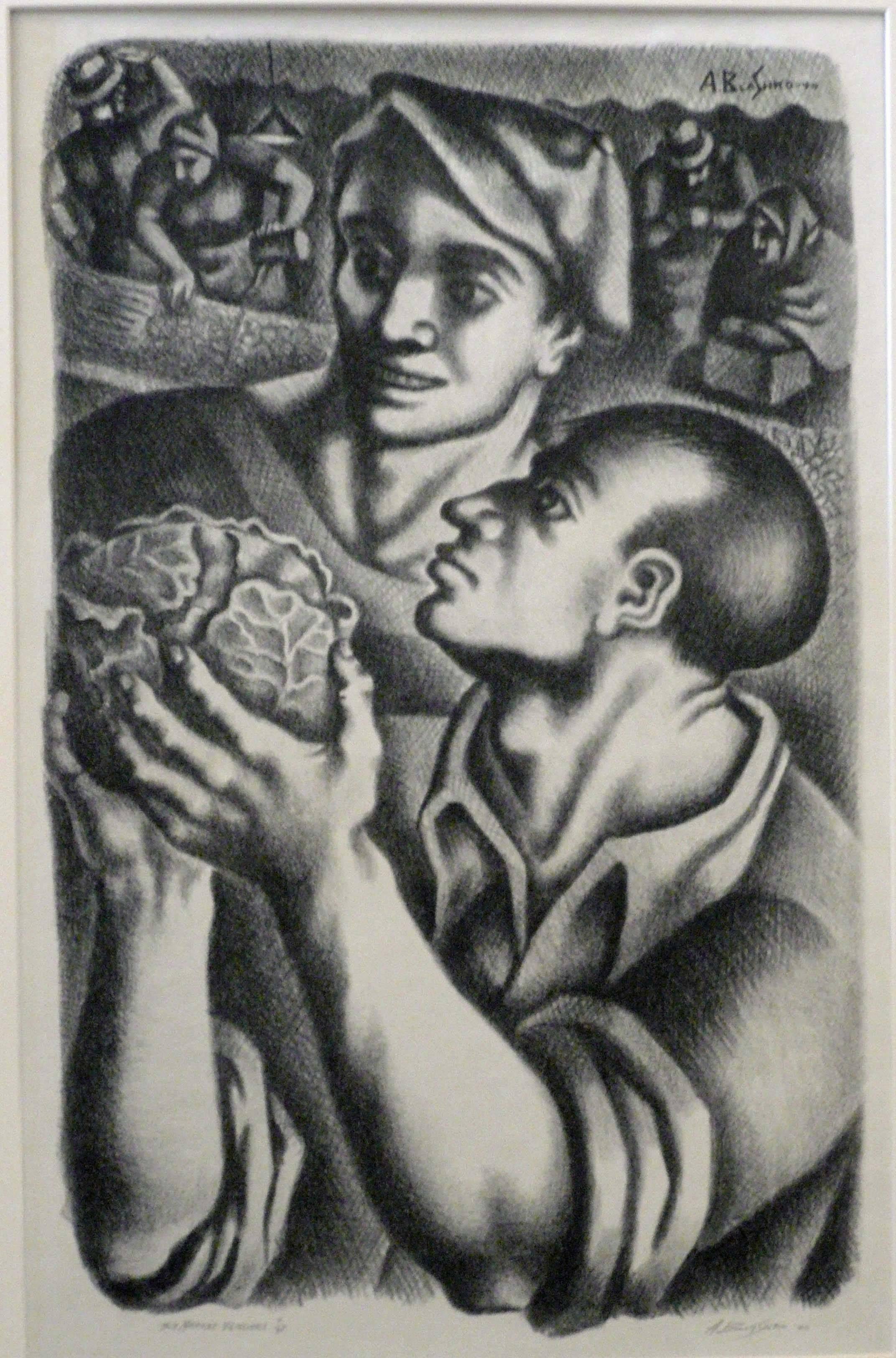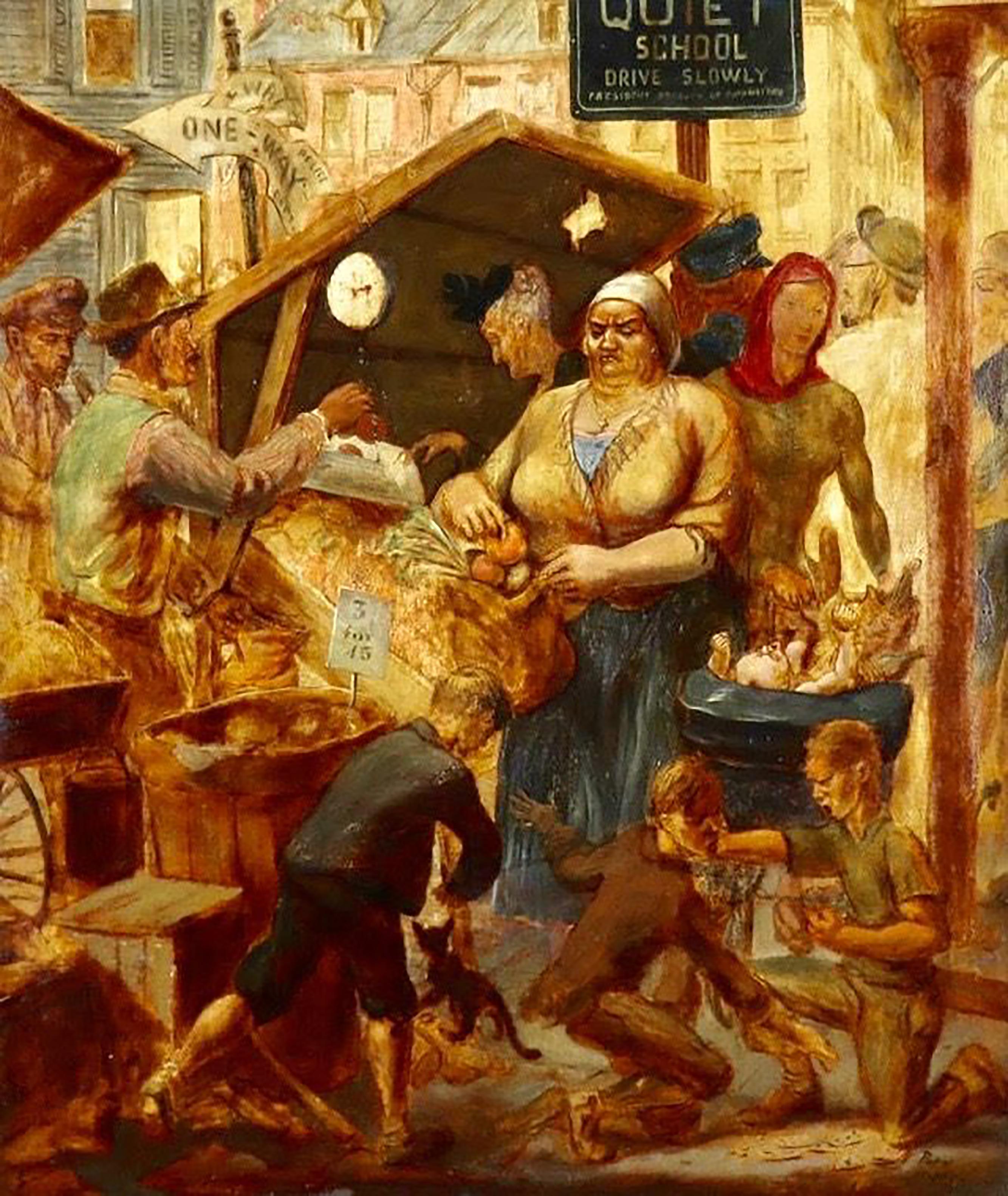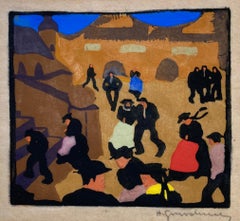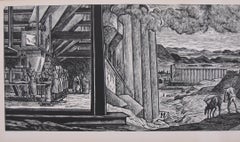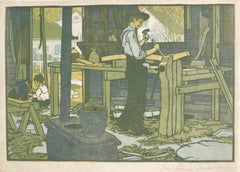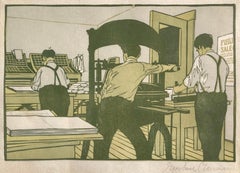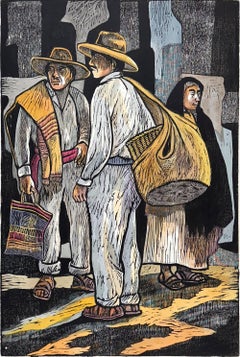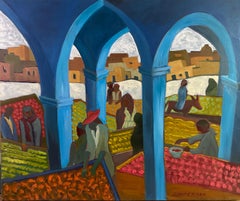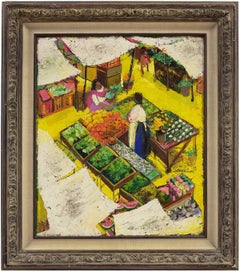Want more images or videos?
Request additional images or videos from the seller
1 of 9
Morton DimondsteinMARKET IN ERONGARICUARO1954
1954
$475
£368.40
€417.57
CA$679.81
A$742.83
CHF 385.11
MX$8,874.15
NOK 4,900.72
SEK 4,588.24
DKK 3,118.10
About the Item
MORTON DIMONDSTEIN (NY 1920 - LA 2000)
MARKET IN ERONGARICUARO 1954
Serigraph, silkscreen. Signed titled and dated in pencil. Image 10 ¼ x 25 ½ inches. Large full sheet 17 1/4 x 30 ¼. Some mild light toning around the image and a little soiling in the margins. Otherwise in good condition.
Erongricuaro is an Artist hangout in Michoacan, Mexico.
Very nice serigraph in the WPA tradition. Morton Dimondstein's serigraphs are rare. There is regionalist scene "Industrial # 1", dated 1948, in the National Gallery of Art from the Dave & Reba Williams Collection of Serigraphy. Serigraphy (Silkscreen) was first used for fine art purposes during the WPA. Although this print is later than that, it harkens back to those images, Dimondstein went on the produce very fine color woodcuts.
The following obituary appeared in the Los Angeles Times on December 7, 2000:
Morton Dimondstein, 80, Los Angeles artist noted for woodcuts in the Mexican realist tradition who also was a collector and curator of African art. Dimondstein grew up in New York City, where he attended the American Artists School and the Art Students League. After serving in the infantry during World War II, he moved to Los Angeles and studied at the Otis Art Institute. Influenced by the Mexican muralist tradition, he lived in Mexico City for several years and produced woodcuts that were praised by the great Mexican painter and muralist David Alfaro Siqueiros. Dimondstein also was a sculptor whose work was called “unpretentious . . . honest, handcrafted” by a Los Angeles Times critic. His paintings and sculptures appeared in many galleries and museums, most recently the Jan Baum Gallery in Los Angeles. He also was prominent as a collector and curator of African art and founded Dimondstein Tribal Arts in 1964 to showcase African tribal art he had collected on travels throughout Europe and Africa since the 1950s. He helped organize the first major U.S. shows of tribal art from the Benue Valley in Nigeria and of Betak art from Sumatra. On Nov. 27 in Los Angeles after a long battle with Parkinson’s disease.
- Creator:
- Creation Year:1954
- Dimensions:Height: 10.25 in (26.04 cm)Width: 25.5 in (64.77 cm)
- Medium:
- Movement & Style:
- Period:
- Condition:
- Gallery Location:Santa Monica, CA
- Reference Number:1stDibs: LU411313000892
About the Seller
5.0
Recognized Seller
These prestigious sellers are industry leaders and represent the highest echelon for item quality and design.
Platinum Seller
Premium sellers with a 4.7+ rating and 24-hour response times
Established in 1977
1stDibs seller since 2016
296 sales on 1stDibs
Typical response time: 1 hour
Associations
International Fine Print Dealers Association
- ShippingRetrieving quote...Shipping from: Santa Monica, CA
- Return Policy
More From This Seller
View AllVILLAGE SCENE / TOWN FESTIVAL
By Herbert Gurschner
Located in Santa Monica, CA
HERBERT GURSCHNER (Austrian / English (1901-1975)
VILLAGE SCENE / TOWN FESTIVAL ca.1924
Color woodcut 4 ¾ x 5 3/8” Signed in pencil. Good strong colors. On thin paper. Faint darkeni...
Category
1920s Modern Figurative Prints
Materials
Woodcut, Linocut
THE MAKING OF TORTILLAS - Mural Size 47 1/2 inches Long
By Leopoldo Méndez
Located in Santa Monica, CA
LEOPOLDO MENDEZ (1902 – 1969)
THE MAKING OF TORTILLAS 1954
Linocut. Edition unknown. This example signed in pencil and dated 1957. 14” x 47 3/8” ...
Category
1950s Modern Figurative Prints
Materials
Linocut
THE WAGON SHOP
By Gustave Baumann
Located in Santa Monica, CA
GUSTAVE BAUMANN (1881 – 1971)
THE WAGON SHOP, 1910 (Chamberlain 24)
Color woodcut signed in pencil. Unnumbed from an edition 100 as published in the Hills o’ Brown...
Category
1910s Modern Figurative Prints
Materials
Woodcut
$1,800 Sale Price
20% Off
The Print Shop
By Gustave Baumann
Located in Santa Monica, CA
GUSTAVE BAUMANN (1881 – 1971)
THE PRINT SHOP 1910 (Chamberlain 27)
Color woodcut signed in pencil. Unnumbed from an edition 100 as published in the
Hills o’ Brown Portfolio, (plate 11 of 12). Image 9 x 13 1/8, sheet 10 ¼ x 13 7/8 with
deckle edge at the bottom. The print portrays the Brown County...
Category
1910s American Modern Interior Prints
Materials
Lithograph
STREET ACAPULCO
By Joseph Pennell
Located in Santa Monica, CA
JOSEPH PENNELL (1857 - 1926)
STREET ACAPULCO 1901-08. Color pastel and gouache drawing on blue paper. Signed and titled in pencil in his early signature. Image, 10 x 14 inches to j...
Category
Early 1900s American Impressionist Landscape Drawings and Watercolors
Materials
Pastel, Mixed Media, Gouache
$900 Sale Price
45% Off
FISH MARKET
By Frances H. Gearhart
Located in Santa Monica, CA
FRANCES H. GEARHART (1869 – 1958)
FISH MARKET 1930
Color block print, Signed and titled in pencil. Image 11 x 9 inches. Full sheet with deckle edges 14 3/...
Category
1930s Landscape Prints
Materials
Woodcut
You May Also Like
El Mercado de Pátzcuaro II
Located in Palm Springs, CA
El Mercado de Pátzcuaro II captures a glimpse of daily life in the highland town of Pátzcuaro, Michoacán. The scene shows three Indigenous figures, rendered with bold lines and earthy tones, standing amid the bustle of the market. Two men in traditional white cotton clothing and wide-brimmed straw hats stand in conversation, their woven baskets and bundles suggesting they are either arriving to sell goods or preparing to return home with their purchases. Beside them, a woman cloaked in a dark rebozo gazes outward, her expression reflective and steady, grounding the composition with a quiet dignity. The strong woodcut textures emphasize folds of fabric, rough straw, and woven fiber, reminding the viewer of the handmade traditions that sustain the culture.
The marketplace of Pátzcuaro has long been a hub of commerce and cultural exchange, and Oñate’s print conveys both the social energy and the rooted traditions of this setting. The figures are depicted not as anonymous passersby but as individuals whose posture, clothing, and belongings tell stories of community, resilience, and labor. The muted yet warm palette, accented with yellows and reds, suggests early morning light spilling across the plaza’s cobblestones, while the abstracted background blocks provide rhythm and structure without distracting from the human presence.
Francisco Rodríguez Oñate (1940–2019) was a distinguished Mexican post-war and contemporary artist whose career extended over several decades throughout Mexico, the United States, and Latin America. Born in Michoacán, he received his education at the Escuela Popular de Bellas Artes at the University of Michoacán, where he studied under esteemed artists such as Alfredo Zalce, Roberto Martínez, and Javier Arévalo...
Category
1990s Contemporary Portrait Prints
Materials
Watercolor, Woodcut
Market Scene
By Angelika Thusius
Located in Milwaukee, WI
"Market Scene" is an original color lithograph by Angelika Thusius. It depicts three women at a market. Thusius uses contour lines and bright oranges and yellows to create this litho...
Category
1970s Figurative Prints
Materials
Lithograph
The Market #2 - by Marc Zimmerman
By Marc Zimmerman
Located in Carmel, CA
The universal farmers market is bustling with action. Geometric stalls with intense color coupled with contrasting blue arches creates the dynamism in this work of art.
The Market #...
Category
2010s American Modern Figurative Paintings
Materials
Canvas, Oil
Market Scene
Located in Surfside, FL
Vibrant market scene with vibrant impasto brushstrokes.
Category
Mid-20th Century Folk Art Figurative Paintings
Materials
Canvas, Oil
MARKET VENDORS
By Abe Blashko
Located in Portland, ME
Blashko, Abe. MARKET VENDORS. Lithograph, 1940. Edition of 35. Signed, dated, titled and numbered 7/35 in pencil, and also signed and dated in the stone. 19 1/2 x 12 inches, 495 x 30...
Category
1940s Figurative Prints
Materials
Lithograph
Market Scene
Located in Fort Washington, PA
Signature: Signed
Category
1940s Figurative Paintings
Materials
Oil, Board
More Ways To Browse
Mexican Michoacan
Morton Brown
Royal Albert Old Country Roses
Salvador Dali 1967
Salvador Dali Mythology
Sem Georges Goursat
Sonia Delaunay Pochoirs
Toyokuni Ii
Vermeer Lithograph
Vintage 1945 Dresses
Vintage Broadway Posters
Vintage Gun Print
William Auerbach Levy
William Lionel Wyllie
Woodcut Print Jacques
15th Century Woodcut
1978 Dali
20th Century French Woodcuts
